
Plumeria, also known as frangipani, is a genus of flowering plants in the subfamily Rauvolfioideae, of the family Apocynaceae. Most species are deciduous shrubs or small trees. The species are native to the Neotropical realm, but are often grown as cosmopolitan ornamentals in tropical regions, especially in Hawaii, as well as hot desert climates in the Arabian Peninsula with proper irrigation.

Crepidium, commonly known as 沼兰属 or spur orchids is a genus of about three hundred species of orchids in the family Orchidaceae. Plants in this genus are evergreen, mostly terrestrial plants with short stems lying on the ground, two or more relatively large, pleated leaves and small, non-resupinate flowers with spreading sepals and petals. The genus is widely distributed in the tropics.
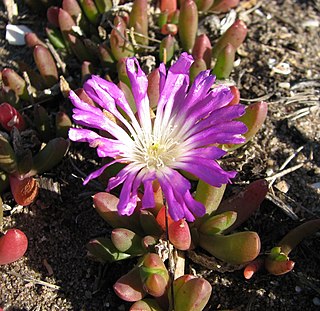
Disphyma is a genus of flowering plants in the family Aizoaceae that are native to New Zealand, Australia and southern Africa. Plants in this genus are prostrate, annual or short-lived perennial shrubs with succulent leaves and daisy-like flowers arranged singly on the ends of shoots with petal-like staminodes, many stamens and usually five styles.
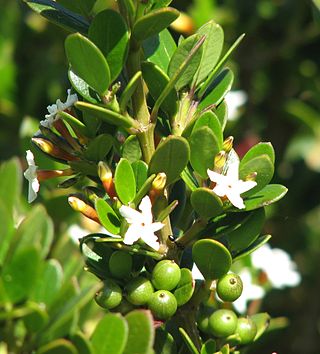
Alyxia buxifolia, otherwise known as the sea box or dysentery bush, is a species of evergreen shrub in the family Apocynaceae.
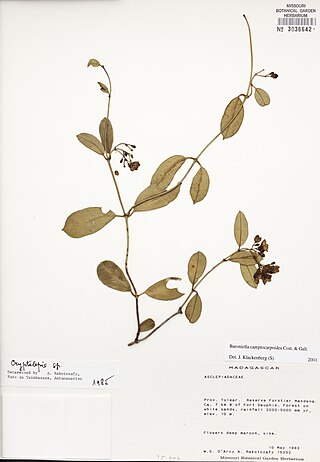
Baroniella camptocarpoides is a species of plant in the Apocynaceae family. It is endemic to Madagascar. Julien Noël Costantin and Ernest-Isidore Gallaud, the botanists who first formally described the species, named it after its resemblance to, but distinctiveness from, plants in the genus Camptocarpus.
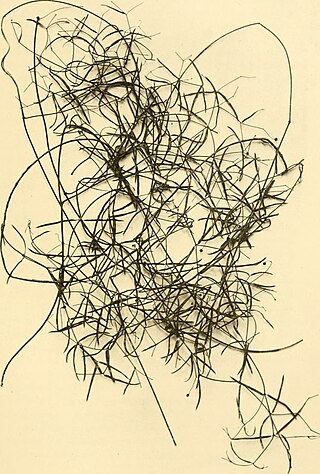
Baroniella linearis is a species of plant in the Apocynaceae family. It is endemic to Madagascar. Pierre Choux, the botanist who first formally described the species using the synonym Baseonema lineare, named it after its narrow leaves.

Batesanthus pseudopalpus is a species of plant in the Apocynaceae family. It is native to the Republic of the Congo and Gabon. Hendrik J. T. Venter and Rudolf L. Verhoeven, the botanists who first formally described the species, named it after the lobes of its corona which they said resemble the pedipalps of the rain spiders Palystes castaneus and Palystes superciliosus.

Batesanthus purpureus is a species of plant in the Apocynaceae family. It is native to the Cameroon, the Central African Republic, Democratic Republic of the Congo, Gabon, Guinea, Ivory Coast, Liberia, and Nigeria. Nicholas Edward Brown, the botanist who first formally described the species, named it after its purple flowers.

Camptocarpus crassifolius is a species of plant in the Apocynaceae family. It is endemic to Madagascar. Joseph Decaisne, the botanist who first formally described the species, named it after its thick leaves.
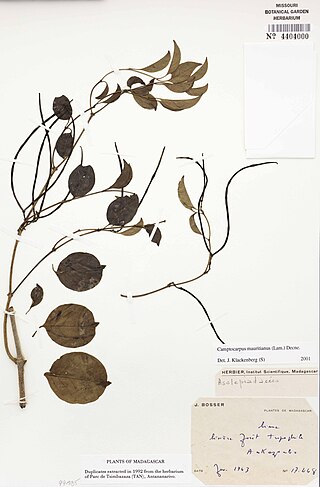
Camptocarpus mauritianus is a species of plant in the Apocynaceae family. It is native to Comoros, Madagascar and Réunion. Jean-Baptiste Lamarck, the naturalist who first formally described the species named it, using the synonym Cynanchum mauritianum, after the region of the Indian Ocean that includes the island of Mauritius, although the type specimen he examined did not list a specific location.
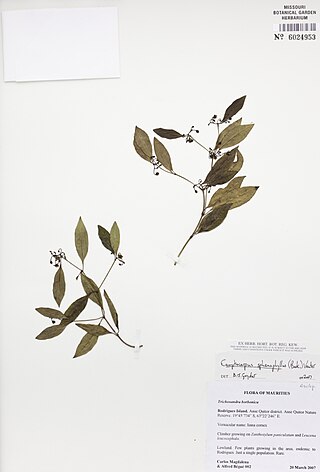
Camptocarpus sphenophyllus is a species of plant in the Apocynaceae family. It is endemic to the island of Rodrigues. Isaac Bayley Balfour, the naturalist who first formally described the species named it, using the synonym Tanulepis sphenophylla, after its wedge-shaped leaves.

Chlorocyathus lobulata is a species of plant in the Apocynaceae family. It is native to the Cape Provinces of South Africa. Hendrik J. T. Venter and Rudolf L. Verhoeven, the botanists who first formally described the species named it, using the synonym Raphionacme lobulata, after the distinctive lobes of the corona of its flowers.

Camptocarpus semihastatus is a species of plant in the Apocynaceae family. It is native to Madagascar. Jens Klackenberg, the botanist who formally described the species named it after the distinct coronal lobes of its flowers that resemble half the head of a spear.

Condylocarpon amazonicum is a species of plant in the Apocynaceae family. It is native to Bolivia, Brazil, Suriname, and Venezuela. Friedrich Markgraf, the botanist who first formally described the species, using the basionym Anechites amazonicus, named it after the area near the Amazon River in Pará Brazil where the specimen he examined was collected by Adolpho Ducke.

Condylocarpon guyanense is a species of plant in the Apocynaceae family. It is native to Brazil, French Guiana, and Guyana. René Louiche Desfontaines, the botanist who first formally described the species, named it after Guyana where Joseph Martin collected the specimen he examined.

Condylocarpon isthmicum is a species of plant in the Apocynaceae family. It is native to Argentina, Brazil, Paraguay and Uruguay. José Mariano de Conceição Vellozo, the botanist who first formally described the species, named it after the narrow neck connecting the two sections of its fruit.
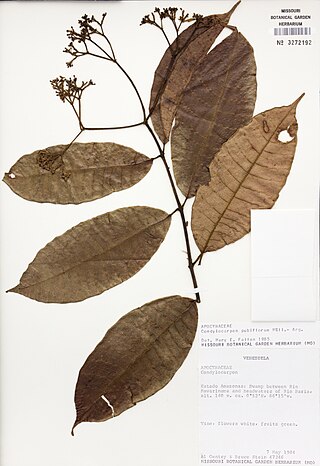
Condylocarpon pubiflorum is a species of plant in the Apocynaceae family. It is native to Bolivia, Brazil, Colombia, Peru and Venezuela. Johannes Müller Argoviensis, the botanist who first formally described the species, named it after an invalid nomen nudum, Hortsmania pubiflora, previously offered by George Bentham.
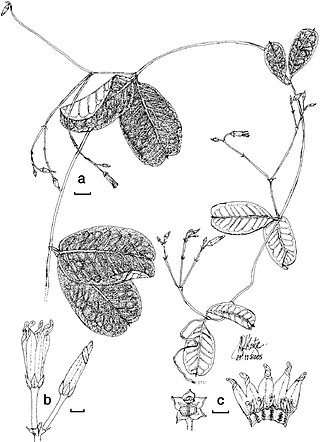
Cryptolepis africana is a species of plant in the Apocynaceae family. It is native to Kenya. Arthur Allman Bullock, the botanist who first formally described the species, using the synonymous subspecies name Cryptolepis sinensis subsp. africana, named it after the location where the sample he examined was collected in East Africa.
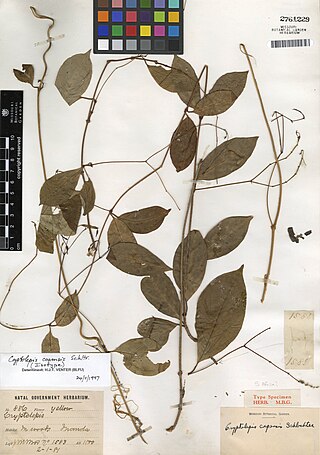
Cryptolepis capensis is a species of plant in the Apocynaceae family. It is native to South Africa and Eswatini. Rudolf Schlechter, the botanist who first formally described the species, named it after the region where the sample he examined was collected in South Africa.
Cryptolepis delagoensis is a species of plant in the Apocynaceae family. It is native to Mozambique and South Africa. Rudolf Schlechter, the botanist who first formally described the species, named it after the location where the specimen he examined was found near Maputo Bay which was then called Delagoa Bay.


















